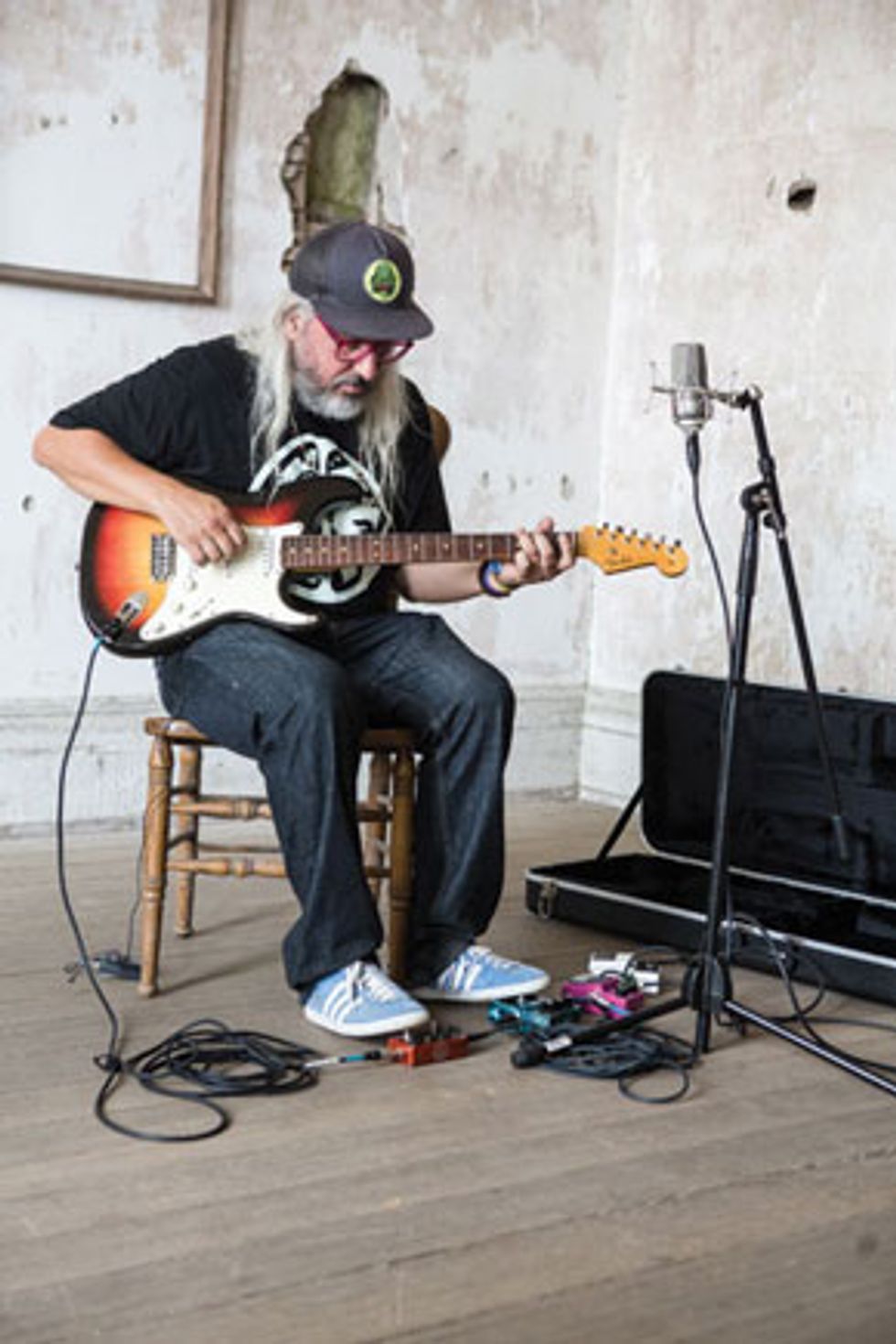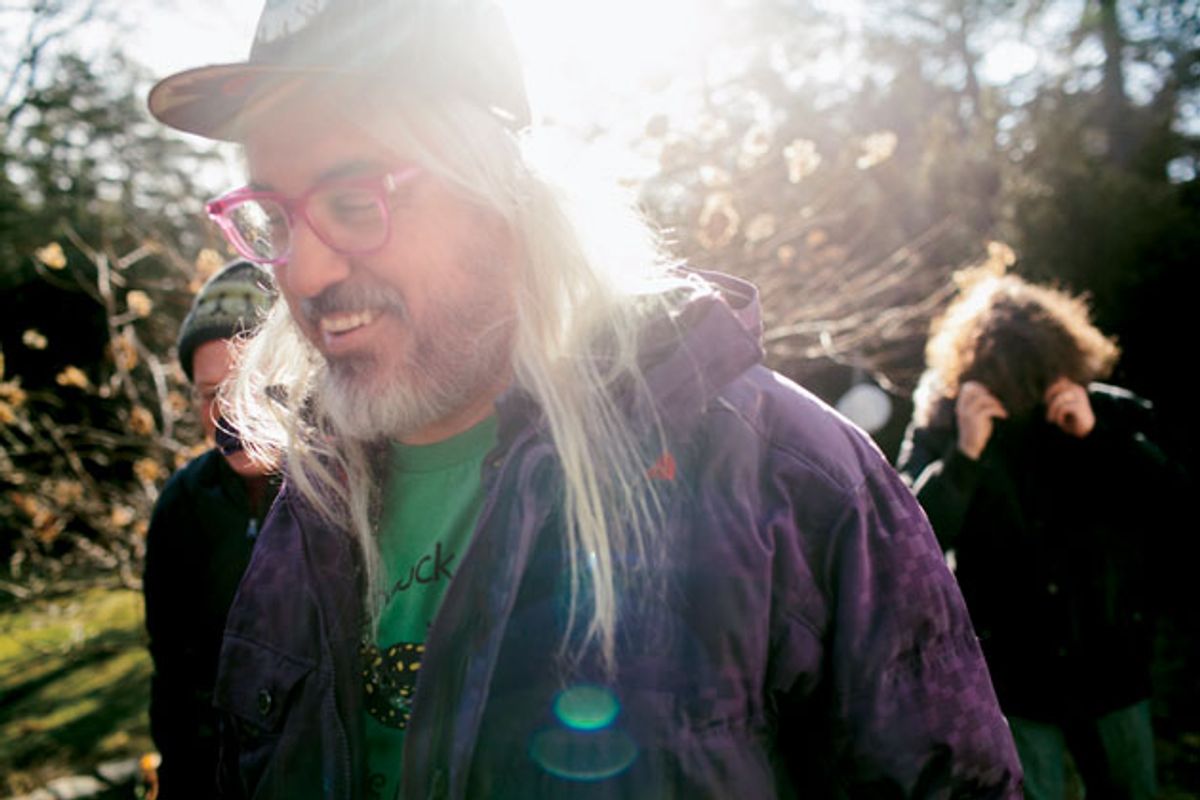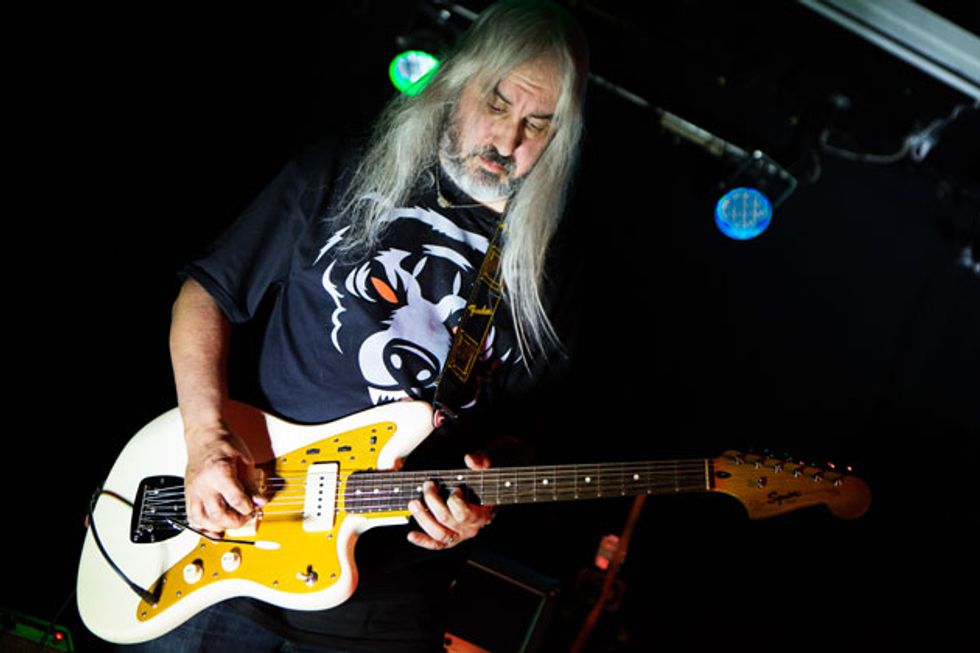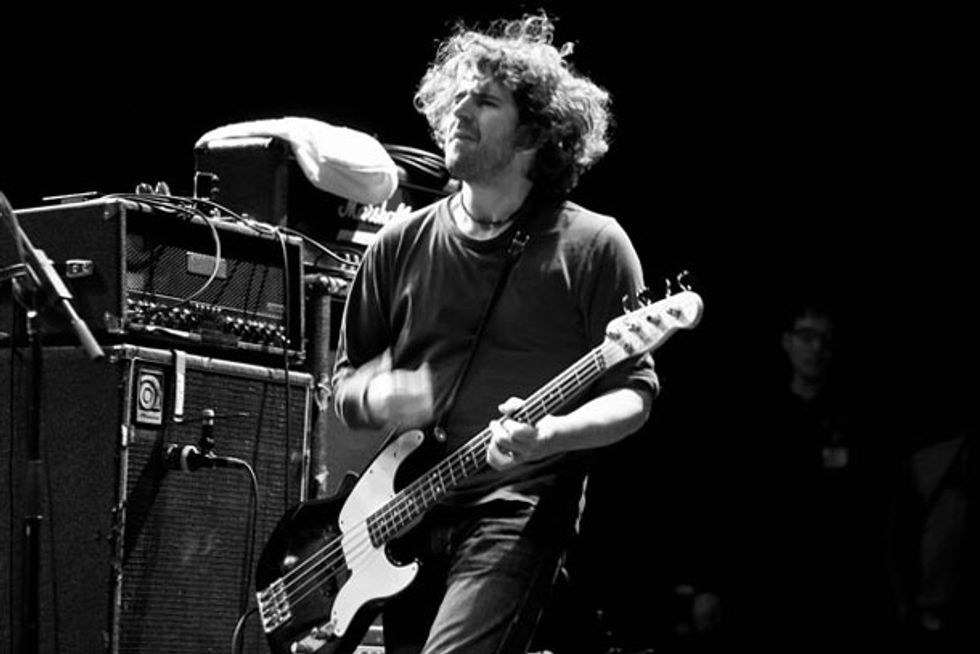Alt-rock guitar hero J Mascis might be soft-spoken, but when it comes to guitar, he blasts everything to 10. Get an inside look at the making of Dinosaur Jr.’s new album, Give a Glimpse of What Yer Not.
J Mascis doesn’t say much, but he doesn’t have to. He’s an alternative rock icon—an awkward guitar hero from a music scene not usually interested in guitar heroes. He plays with grace, finesse, and stubborn self-confidence; churns out riffs with abandon; and writes artful but listenable songs. He plays loud, too. But volume isn’t a gimmick. It’s an aesthetic statement that’s also tuneful and tasteful.
Mascis has been around for a while. His band, Dinosaur Jr., started in Western Massachusetts in the mid-1980s and rose from the ashes of Deep Wound, a hardcore band that featured Mascis on drums. Dinosaur Jr.—with Mascis on guitar, Lou Barlow on bass, and Murph on drums—was loud, audacious, and influential, releasing three acclaimed albums, including their 1985 debut Dinosaur, You’re Living All Over Me (1987), and Bug (1988), before unraveling in 1989. Mascis soldiered on without his original mates, and the band signed with a major label, Sire, in the early ’90s. They got significant exposure and released a number of alternative anthems like “Out There” and “The Wagon.” But by decade’s end, Dinosaur Jr. had morphed into J Mascis and the Fog, and that seemed to be the end of the line.
But not so fast.
In 2005, the original Dinosaur Jr. reunited. It was no cheesy trip down memory lane. They picked up where they left off, toured, returned to the studio, and released three new albums hailed by critics as vital and relevant—an unusual feat for a middle-aged rock band. Their latest, Give a Glimpse of What Yer Not, is due on August 5 and is a testament to their tenacity and consistency.
Dinosaur Jr.’s core is, quite literally, Mascis’ wall of sound. Onstage, Mascis stands in front of six 4x12 cabinets—powered by two vintage Marshall heads and an ancient Hiwatt—and a blackface Fender Twin. He doesn’t switch between amps. He runs all four simultaneously and blasts them at full tilt. He uses pedals to create contrasts—his pedalboard is brimming with goodies—and he plays on an assortment of Fender Jazzmasters.
His idiosyncratic tastes have spawned a small industry of gear, including a high-end signature Jazzmaster, its more affordable Squier iteration, and the coveted and rare Fuzz Munchkin dirt box from Tym Guitars in Australia.
PG spoke with Mascis about his influences, capos, the different gear he uses in the studio, subliminal songwriting, his pedalboard philosophy, and how his playing has evolved over the last 30 years.
You started playing the guitar relatively late. Did it take time to get up to speed? Yeah. I played a lot. I wrote my own songs, so I only had to play what I wrote and vice versa. It wasn’t too bad because I wasn’t trying to play covers or anything.
Did it help that you knew music and already played drums? Yeah, for sure. And I fooled around on guitar—I’d written some songs already.
When you switched from drums to guitar, the type of music you were playing also transitioned—from hardcore to what you do now. Was that a natural transition for you? Yeah, that’s why I switched. We knew we were going to play a different style of music and I didn’t like any of the guitarists around town. I thought it would be easier to find a drummer, show him what to play, and figure out the guitar on my own. Nobody I knew really was playing guitar in a way that I wanted to hear.
You’ve said that two of your big influences were Mick Taylor and Keith Richards. How did they influence you? When I was learning, I liked playing solos more than rhythm—so Mick Taylor’s sound. Keith Richards had some cool leads, too, and recognizable rhythm sounds.
Did you experiment with open tunings, like Keith? Not at first. I did use the Keith tuning [open G] on the new album, on the song “Goin Down.”

Although Mascis, shown here with a Stratocaster, plays mostly Fender Jazzmasters onstage, including a signature model, he uses a wide range of guitars and amps to get his varied studio tones. Photo by Tim Bugbee/Tinnitus Photography
Did Richards inspire you to use a capo as well? No. That was just from trying to sing. The first song I used a capo on was “Little Fury Things” [from 1987’s You’re Living All Over Me] after realizing it wasn’t a good key for me to sing in. From then on I’ve been using it. I never really write songs in the right key to sing. I use a capo to get a little better range for my voice.
You write a song and then move the capo around until you find something that fits comfortably in your vocal range? Yeah. I end up singing falsetto a lot when I’m writing songs. But I don’t necessarily want to sing all the songs falsetto.
Does using the capo mess with your intonation, especially since your action is so high? I have to tune it every time I move the capo. I always wonder—when I see people play guitar, throw the capo on, and keep playing—“How is that possible?” That’s never worked for me.
Do you find it limiting when soloing since you’re cutting off a big chunk of the fretboard? I don’t mind soloing with the capo. It doesn’t bother me, but a lot of capos don’t seem to be able to hang on when you bend the strings. I’ve only been able to use the Shubb capos. They clamp down real tight.
Another influence you’ve mentioned is Ron Asheton from the Stooges. What did you learn from him? His sound on the first Stooges albums—I’ve always been chasing that as the ultimate guitar sound. Also, the way he soloed, it was more in my reach. I could figure out what he was doing—it wasn’t so hard. He was a good role model for learning how to play.
The Jazzmaster was your first good guitar. What were you playing on before you got one? I had Lou’s old guitar. It was, like, a Hondo Les Paul copy.
You’re known for using Jazzmasters live, but in that new clip from Later… with Jools Holland you’re playing a Tele with an f-hole. What’s up with that? I just thought I would try it because that song—that’s the Keith tuning—has kind of a heavier sound I was going for. I’m not sure if I’ll stick with it. It had a humbucker, a noise-canceling pickup, in it, too.
Talk about the different gear you use in the studio. I have a lot of guitars. I’ll use a lot of Gibsons for rhythm, and Teles I’ll use a lot for leads. I usually use a Vox AC-15 from 1959 or a Tweed Deluxe—the Tweed Deluxe maybe more with the Gibsons for rhythm and then the Vox with the Fenders for leads. That’s kind of my main thing. I usually play in the control room. I have the amp there and the speaker somewhere else.
Do you use your pedalboard in the studio? I’ll just use whatever pedal. I don’t use the pedalboard at all.
Dinosaur Jr. isn’t the only home for Mascis’ raging guitar solos. He’s shown here performing with his side project Heavy Blanket at San Diego’s the Satellite in June 2013. Photo by Debi Del Grande
You often have multiple guitar parts on your records. “Be a Part,” from the new album, is a good example. What’s your approach to arranging and layering different guitar parts? Trial and error in the studio—just what I think sounds good. Usually I’ll go too far and then bring it back. I add a bunch of stuff and just keep the stuff that works.
On “I Walk for Miles,” you have all these different entrances and different tones. How do you approach crafting a diverse palette of sounds over the course of an album? Mostly song by song. I just see what I think is appropriate for each song. They end up sounding a little different. There are a lot of different types of songs on this record.
Do you ever think, “This album has too many similar sounds and I need to change it up?” Not exactly. I’ll just think, “This song isn’t really exciting me. I’ve got to add something.” I’m not comparing the songs. I take each song on its own and try to make it interesting.
When recording, do you cut scratch tracks, strip everything away except the drums, and redo everything? Or do you record as a band and then build off what you have? The first way—usually just save the drums. Sometimes the bass, but mostly just the drums. I did end up using one part of the scratch guitar in one song: “Tiny,” just in one section. There was a part I liked and kept. We’re not that tight. We don’t practice beforehand so we’re recording as we’re practicing. It’s not like we have the songs totally together first. There’s definitely some arranging going on still—how many times this part or that part, but mostly the parts are written.
I’ve heard that when you write songs, you watch TV, play guitar, and wait for something to happen. How does that work? I liken it to fishing. You’re sitting waiting for something to happen. TV kind of passes the time. I’m just playing and waiting for something I like.
J Mascis’ Gear
GuitarsAssorted Fender Jazzmasters including a ’63, a ’65, and a signature Squier model (modded with Seymour Duncan Antiquity pickups) Fender Thinline Telecaster Gibson CF-100 (acoustic)
Amps
Two late-’60s Marshall Super Bass heads
Vintage Hiwatt DR103
1967 blackface Fender Twin
4x12 Marshall cabinets from the ’60s and ’70s (six)
1959 Vox AC15
Fender Deluxe tweed
Effects
Bob Bradshaw Custom Audio Electronics switcher
ToneBender Mk I-clone/Rangemaster-clone combo pedal (built by Built to Spill’s Doug Martsch)
Electro-Harmonix “Ram’s Head” Big Muff
MC-FX clone of a Univox Super-Fuzz
CAE Twin Tremolo
Z.VEX Double Rock (two Box of Rocks in one)
Electro-Harmonix Electric Mistress
Moog MF Delay Minifooger Analog Delay (with expression pedal)
Mooer Reecho Analog Delay
Boss TU-2 Tuner
Custom switch to limit the Big Muff
Strings and Picks
Ernie Ball Cobalt wound strings and RPS (with a reinforced ball end) unwounds (.010–.046)
Purple Dunlop Tortex (1.14 mm)
Shubb capos
Is film scoring different than writing songs? It’s a bit easier because you’ve got something there to work with. You can watch the scene and a lot of times it will write itself. Writing songs is like pulling stuff out of thin air. If you’ve got a picture and a feeling in the movie already; it’s a lot easier to come up with something.
You’ve also said, “Songs are just excuses for solos.” Do you mean that? [Laughs.] Well, in a way it’s true. [Laughs.]
Your standard setup is two old Marshall heads, a Fender, and the Hiwatt, but for fly-dates you’ll usually have three newer Marshalls. Can you tell that something is different? Does it feel funny? Yeah, for sure. A lot of the new amps that you’ll get sound really bad compared to the older amps that I have. But you can’t do much about it—just get used to it for the day and hopefully it’s not too bad. They’re usually really treble-y or something.
There is no way to roll that back? Not really [laughs.] No.
And how do you use pedals for different volume jumps? What is your philosophy with pedals? You know how people complain when they step on a fuzz and they say it gets quieter? I turn the Big Muff all the way up and that’s the loudest sound I have. I have that as loud as it will go and my other sounds I turn down to make sure [the Big Muff is] the loudest. For my cleaner sounds I use a tube driver just to turn down the sound. It still has a little bit of grit but the volume will be really low—it will be lower than just playing straight into the amp, but when you kick on the Big Muff it will get louder. I also have a pedal that turns down the Big Muff. When I’m playing rhythm I’ll have the Big Muff quieter and then for solos it goes all the way up.
Is that a custom thing? Yeah. I also built that into the Fuzz Munchkin. It has a switch to make it go all the way up and then a volume control to turn it down for rhythm and lead.
How do you think your playing has evolved over the last 30 years or so? Oh, you know, it’s gotten better and worse. Some things seem better, but I think as you play more, you get those reps in your mind and you’re not as inventive as when you didn’t know how to play. I think I’ve learned some palm muting in the last three years or so, which I never knew how to do before. I’m sure I can play faster than I need to play.
Are you working on learning any other cool techniques? I’m working on fingerpicking on the acoustic. I haven’t gotten very far with that, but I’m always trying it. I’m not at the hybrid-picking phase yet. I’m still putting the pick down. If I’m playing live I’ll always end up using a pick. I haven’t gotten to the point where I can do it live.
YouTube It
Last year, Dinosaur Jr. celebrated the 30th anniversary of the release of their debut album, Dinosaur, with seven sold-out nights at New York City’s Bowery Ballroom. They were joined by fellow alt-rock pioneer Bob Mould during the sixth evening for a literally roaring rendition of “Freak Scene,” from 1998’s Bug. The video opens with a close-up on Mascis’ pedalboard and peaks with Mould and Mascis generating a tsunami of sound.
Barlow’s guitar-like playing style is often similar to Lemmy Kilmister’s, using chords strummed with a pick and pushed through two or three high-wattage amplifiers.Photo by Tim Bugbee/Tinnitus Photography
How Lou Barlow Keeps His Bass in Your Face
Lou Barlow started playing with J Mascis when they were in high school. Back then, Barlow played guitar and Mascis played drums, but that changed with the dawn of Dinosaur Jr. and Mascis’ emergence as one of alternative rock’s premier guitarists. Barlow switched to bass—an instrument he attacks like a guitar, plays chords on, and strums. He left Dinosaur Jr. in 1989 but continued making music with his band, Sebadoh, and even scored a hit in early 1996 with the Folk Implosion (“Natural One” peaked at No. 29 on the Billboard Hot 100) before reuniting with Mascis and Murph in 2005. His unorthodox bass style is the perfect foil to Mascis’ wall-of-sound approach. It’s complementary without being competitive and leaves plenty of room to get messy.Talk about your role as bass player in a power trio. From the beginning, the point was to try to be heard. In the very beginning, J put it forth that we were going to be loud. Our very first practice was just excruciating. J was wearing these blast muffs—those protective headphones—and that put it into Murph and I like, “Oh boy, we’re going to have to really work to be heard.” My style developed out of that. I really hit the bass hard. I was a rhythm guitar player in a hardcore band before that.
What was the transition like, from guitar to bass?
It was effortless. [Laughs.] I was also playing ukulele and that’s how I started writing songs—the less strings the better was my attitude back then.
How has your bass playing evolved over the years and, in particular, how is it different in this iteration of the band as opposed to back in the ’80s?
After I was kind of removed from Dinosaur, I started other bands that I played bass in. I played bass in a band called Folk Implosion, where I played primarily with my fingers. I played almost like a deeper, dub-style bass. That did pretty well. The core of the band was myself playing bass and my partner (John Davis) playing drums—so we made a band that was much more rhythmic. When I came back to Dinosaur, slowly playing with my fingers worked its way into my style.
How do you decide when to use fingers and when to use a pick?
I guess some things obviously call for playing with your fingers [laughs]—like a more traditional style. Other times it really is better to play with full-on strumming, like I used to.
Lou Barlow’s Gear
Guitars’70s Gibson Grabber with sliding humbucker
Rickenbacker 4001
Amps
Marshall 800 and 4x12 cabinet
Mid-’70s Ampeg SVT head and cabinet
Peavey Centurion Mark III head and 1x15 cabinet
Effects
Xotic Bass BB Preamp (on SVT only)
Palmer Triage Amp Selector
Strings and Picks
Ernie Ball Regular Slinkys (.050–.105)
Purple Dunlop Tortex 1.14 mm
Who are some of your influences on bass?
Jah Wobble [from Public Image Ltd] and Lemmy.
Lemmy also did a lot of that guitar-style bass playing.
Yeah, Motörhead was definitely a big deal to us when we were in high school.
Talk about your amps.
I usually play an old SVT through a regular SVT cabinet. It’s really heavy and great sounding. I also play a Marshall 900 guitar head through a 4x12 cabinet. And at home, when I have my real rig, I play a transistor Peavey head through a 1x15, because that’s the original sound that we used to have. I still really like it. I like a really overdriven transistor coming through a 15. It just has a certain familiar sound. I mix the three together.
That is massive.
Yeah. But, I mean, J is playing through three full stacks and a Twin, usually.
Can you feel the air move when you’re standing in front of it?
The main thing is the feel. From the very beginning of the band, really, J wanted it to be an almost physical thing. He wanted the music to register physically as much as hearing it.
In the studio, do you mic your amps or go direct?
Both. But in the end we generally rely on the amped sound.
Do you use the same rig that you use live in the studio?
I did this last record. It depends. It seems to change every record. On [one] record we put everything through a Traynor—a Traynor head—and that just seemed to work. The next time I did everything primarily through an SVT. This last time it was really a combination of the Peavey and a Marshall.
- What Happened to J Mascis’ Jazzmaster Addiction? - Premier Guitar ›
- What Happened to J Mascis’ Jazzmaster Addiction? - Premier Guitar ›
- Dunlop Introduces the Pivot Capo - Premier Guitar ›
- Rig Rundown: Dinosaur Jr.'s J Mascis [2022] - Premier Guitar ›
- Black Belt Eagle Scout’s Katherine Paul’s New Album - Premier Guitar ›




